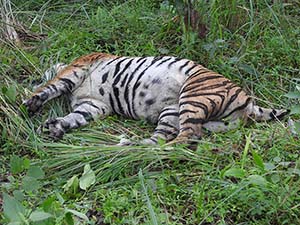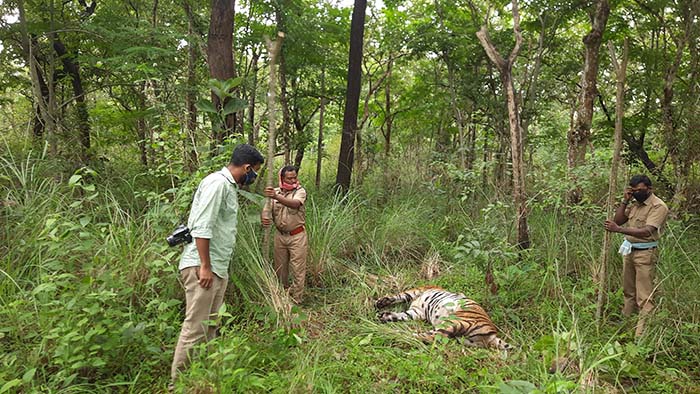Trampled Tiger : Death in an Elephant Corridor
18 August, Wayanad: In an incident that has left many flummoxed, a carcass of a young 10-year-old tigress was found in an elephant corridor in Wayanad. WTI’s Field Officer Shajan M A was part of the expert committee formed for the post-mortem of the tigress that revealed evidence of a fight with a herd of elephants.
Tigers are known to prey on elephant calves but this was a rare instance when a tiger was ostensibly killed by elephants. There were no external injuries and the reason of the death was due to “abnormal rotation of the head, dislocation of the atlanto-occipetal joint and rupture of the spinal cord”.

Pic Courtesy : P K PRABHENDERANATH
Patrolling staff of the Wayanad Wildlife Sanctuary found the carcass on the 26th of July, 2021. The tigress, tagged as ‘Wayanad Wildlife 10’, was not new to these forests and had been regularly captured in camera traps in the past. Her untimely death in her home range was most surprising.
A tiger will generally avoid an altercation with an elephant herd but this wasn’t the case here. India’s 30,000 elephants and 3000 tigers co-exist with its 1.3 billion people in rapidly fragmenting habitat that brings in conflict situations. Despite these two animals being flagships of wildlife conservation in the country and sharing the same space, there is little room left in the corridors that we are fighting to protect.

The tiger was killed near an IB road of the Muthanga Range but not too far from the location is the national highway near Wayanad. As Shajan recalls, “After my Muddhahalli corridor visit, I was back in Wayanad on the evening of the 25th, when I sighted an elephant herd with two calves crossing the national highway”. The very next day, he gets a call from the wildlife warden of Wayanad on the tiger death. “It could have been the same herd”, he observed.
The state of wildlife corridors in our country
This also points out to how fragile our protected areas and wildlife corridors have become. Shajan added, “not too far away from the location of the incident are villages. Also, with the tourism opening up and safari jeeps back on the tracks, wildlife is getting cornered again after a considerable gap.” While this might not have been the explicit reason for the death, these certainly are factors that are breaking the delicate balance of the ecosystem here.
In a first of its kind of initiative, WTI has mapped 101 elephant corridors across the country and secured six corridors. However, identifying these crucial wildlife passages is just the first step towards their protection. Most elephant reserves and corridors are in fact very close to human habitation and use. Unless, this is mitigated, the “big squeeze” will even get tighter and eventually choke our wilderness.









